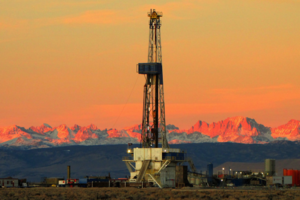Difference between revisions of "Help:Tutorial"
Cwhitehurst (talk | contribs) |
Cwhitehurst (talk | contribs) |
||
| Line 74: | Line 74: | ||
*Equations that include text are set off by the <nowiki>\text</nowiki> tag, with the desired text set within {brackets}. | *Equations that include text are set off by the <nowiki>\text</nowiki> tag, with the desired text set within {brackets}. | ||
*Other important functions can include <nowiki>^ or _ for sub- or superscript, \times and \minus or - for multiplication and subtraction, and \sum for a summation.</nowiki> A typical equation might look like this in wikitext | *Other important functions can include <nowiki>^ or _ for sub- or superscript, \times and \minus or - for multiplication and subtraction, and \sum for a summation.</nowiki> A typical equation might look like this in wikitext | ||
| − | ::<nowiki><math>\text{Hydrocarbon tilt} = \ | + | ::<nowiki><math><math>\text{Hydrocarbon tilt} = \rho_w/(\rho_w - \rho_h) \times \text{potentiometric gradient}</math></nowiki> |
:and come out looking like this: | :and come out looking like this: | ||
::<math>\text{Hydrocarbon tilt} = \rho_w/(\rho_w - \rho_h) \times \text{potentiometric gradient}</math> | ::<math>\text{Hydrocarbon tilt} = \rho_w/(\rho_w - \rho_h) \times \text{potentiometric gradient}</math> | ||
==Tips and tricks== | ==Tips and tricks== | ||
Revision as of 18:49, 25 March 2014
Here is a comprehensive guide to help you learn the ropes of creating and editing pages in AAPG Wiki. This tutorial is aimed at beginners. You can experiment with what you've learned in your Sandbox. THIS PAGE IS STILL IN PROGRESS.
Basics of wikitext
The markup language for all mediawiki sites is called "wikitext." It is a bit different from HTML, but the principle is similar.
Linking
- Link to pages in the wiki with double brackets:
- [[Carbonate reservoir models: facies, diagenesis, and flow characterization]] becomes Carbonate reservoir models: facies, diagenesis, and flow characterization
- If the page you want to link to doesn't match the text you want to link with, add a pipe after the page name with the text you want:
- [[Carbonate reservoir models: facies, diagenesis, and flow characterization|Carbonate diagenesis]] becomes Carbonate diagenesis
- To link to a subheading of an existing page, add a # between the page name and the subheading:
- [[Carbonate reservoir models: facies, diagenesis, and flow characterization#Carbonate reservoir models|Carbonate reservoir models]] becomes Carbonate reservoir models
- Link to external sources with one bracket, followed by the url, a space, and the text you want displayed:
- [http://en.wikipedia.org/wiki/Carbonate Carbonate] becomes Carbonate
Images
- To insert an image into an article, you must first download the image to your computer and then hit Upload file (in lefthand menu). Once the file is uploaded, click the picture icon in the wikitext menu of the article you are working on. This will open a dialog box that will prompt you for more information. Enter the filename of the image you uploaded, and a caption. The default setting are to display the image as a thumbnail, on the right side of the page. Your wikitext will look like this:
- [[file:PinedaleFieldLandRig.png|thumb|Figure 1. Pine Dale Field Land Rig]] and come out looking like this:
- To link an in-text reference to the corresponding figure, add a colon (:) before "file" and the text you wish to appear after the pipe (|):
- [[:file:PinedaleFieldLandRig.png|Figure 1]] becomes Figure 1
References & Citations
- References are a little more complicated. All reference consist of a citation and an actual reference. The citation is a tag that contains a shorthand form of the reference, and is followed, on first use in an article, by the completed reference.
- To create a reference:
- First citation in article:
- <ref name=Whitehurst_1986>Whitehurst, C., 1986, The birth of a genius: AAPG Memoir 42, 27 p.</ref> becomes [1]
- Subsequent citations:
- <ref name=Whitehurst_1986 /> which will automatically create a footnote marker that will link to the original reference: [1]
- If there aren’t any references in the page, you need to create a template for a reference list:
- ==References==
- {{reflist}}
References
Searching
There are several ways to search within the wiki.
- You can use the search box in the upper right-hand corner. You can search for the name of an article, or any term that appears in an article.
Tables and Equations
Tables and equations are fairly complicated. This is a very brief rundown. For a more thorough explanation, see Wikipedia's Help pages on formulas and tables.
Tables
You can create tables manually or using the editing toolbar. By clicking the "Advanced" button, you'll get a drop down table that include, on the far right, a table. The default settings will cause this to appear in wikitext:
- {| class="wikitable"
- |-
- ! Header text !! Header text !! Header text
- |-
- | Example || Example || Example
- |-
- | Example || Example || Example
- |-
- | Example || Example || Example
- |}
which will look like this:
Header text Header text Header text Example Example Example Example Example Example Example Example Example
Equations
- Equations use the LaTex markup language, and are always bounded by <math> and </math> tags. A simple equation will be written much as it appears:
- <math>A + B = C</math> will appear as
- Equations that include text are set off by the \text tag, with the desired text set within {brackets}.
- Other important functions can include ^ or _ for sub- or superscript, \times and \minus or - for multiplication and subtraction, and \sum for a summation. A typical equation might look like this in wikitext
- <math><math>\text{Hydrocarbon tilt} = \rho_w/(\rho_w - \rho_h) \times \text{potentiometric gradient}</math>
- and come out looking like this:


